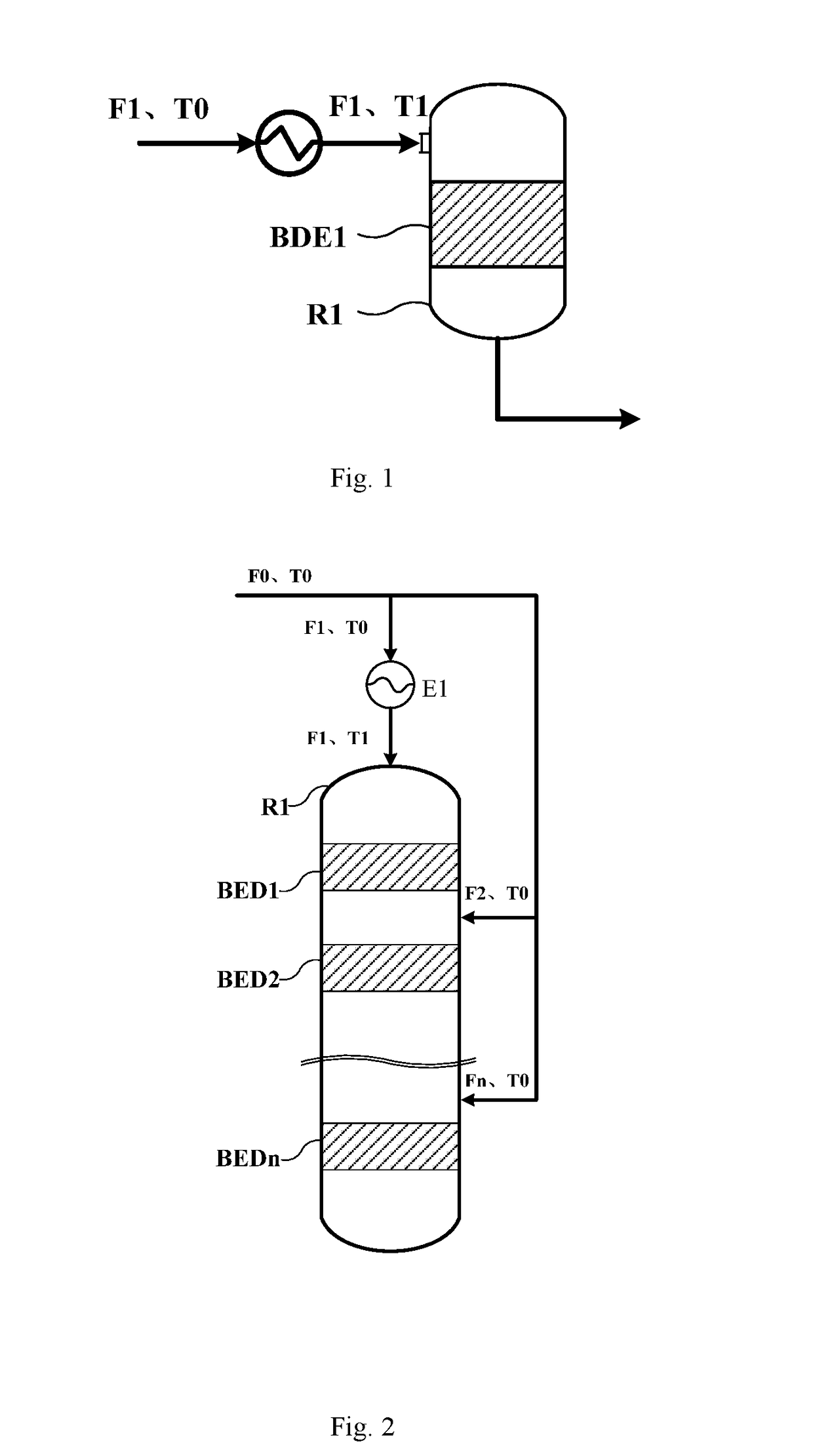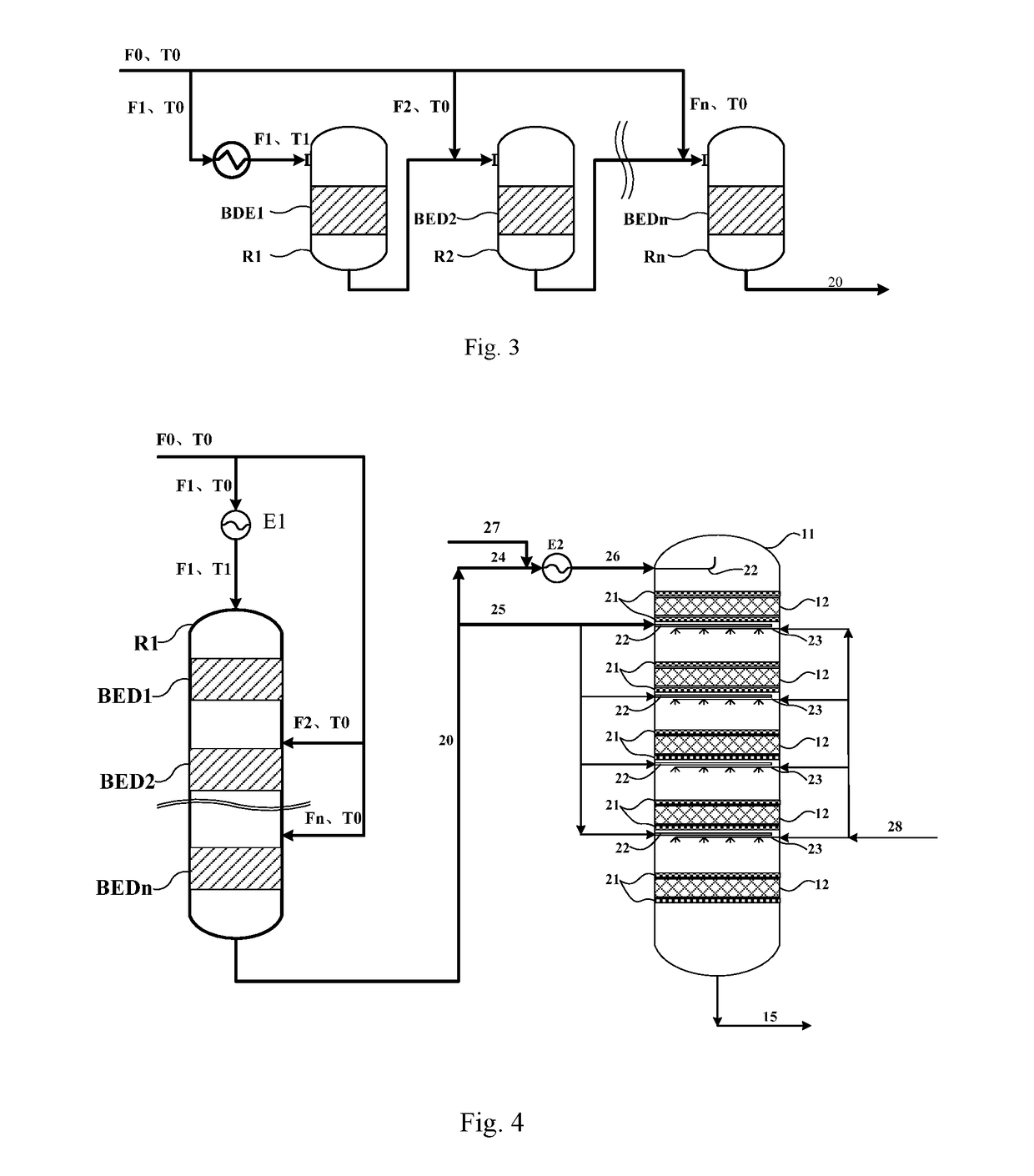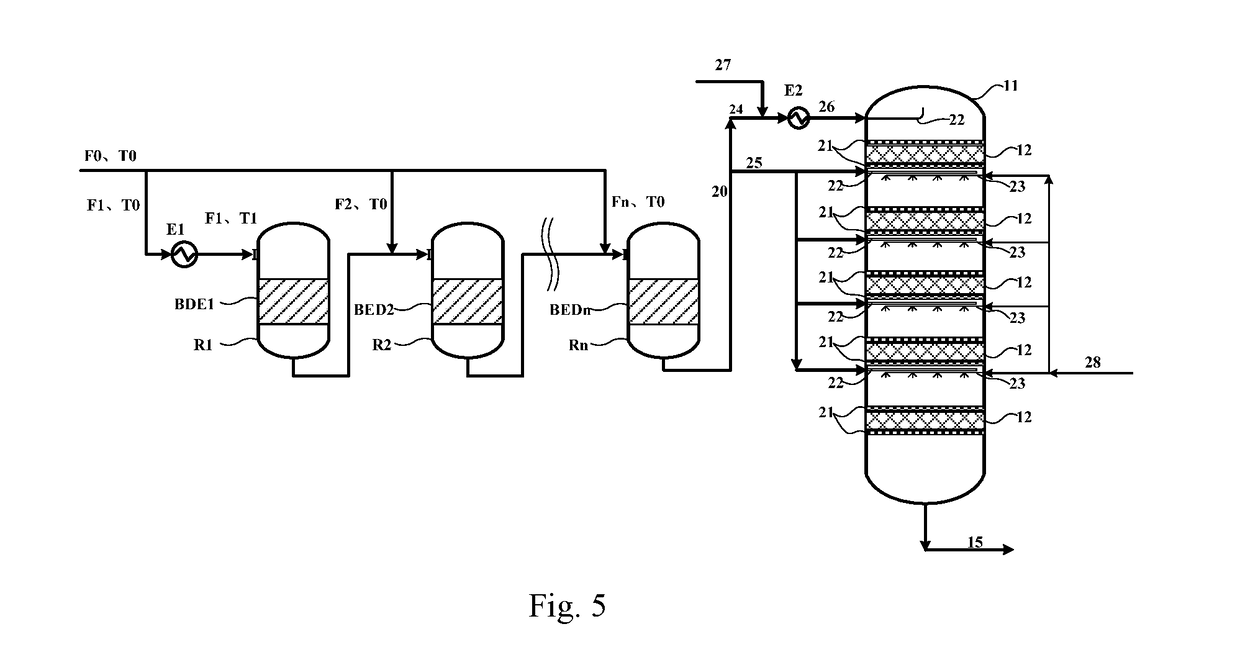Method and reaction equipment for preparing dimethyl ether and olefin from methanol
a technology of dimethyl ether and olefin, which is applied in the preparation of ether, ether preparation, and ether by compound dehydration. it can solve the problems of easy aging of catalysts, high energy consumption of feed materials, and shorten catalyst life, so as to improve the efficiency and convenience of use, the startup and operation process is very simple, and the effect of convenient and easy operation
- Summary
- Abstract
- Description
- Claims
- Application Information
AI Technical Summary
Benefits of technology
Problems solved by technology
Method used
Image
Examples
example 1
[0104]Industrial methanol with purity higher than 99 mass % is used as the raw material, the catalyst SMAP-500 from SINOPEC Shanghai Research Institute of Petrochemical Technology is used as the catalyst, altogether 6 catalyst bed layers are deployed (i.e., n=6), the pressure in the fixed bed reactor is 0.5 MPaG, the space velocities of the materials fed to the catalyst bed layers are 3.5 h−1, 2.5 h−1, 2 h−1, 1.5 h−1, 1 h−1 and 1 h−1 respectively, and the process flow shown in FIG. 4 is used for the methanol-to-dimethyl ether reaction, wherein, T0=150° C., F0=1,000 kg / h, F1=700 kg / h, and thereby K1=0.7. Calculated with the formula 290−50K1≤T1≤150K12−271K1+397.5, the result is 255≤T1≤281.3; the T1 is set to 260, 275 and 280° C. for the temperature of the material fed to the first reaction zone respectively, Ki=(1−Σi=1i−1K)×70% is used for the reaction, and the measured outlet temperatures, hottest-spot temperatures, and conversion rates of methanol in the reaction zones BED 1˜BED6 ar...
example 2
[0108]Industrial methanol with purity higher than 99 mass % is used as the raw material, the catalyst SMAP-500 from SINOPEC Shanghai Research Institute of Petrochemical Technology is used as the catalyst, altogether 3 catalyst bed layers are deployed (i.e., n=4), the pressure in the fixed bed reactor is 0.1 MPaG, the space velocities of the materials fed to the catalyst bed layers are 3 h−1, 2 h−1, 1.5 h−1 and 1 h−1 respectively, and the process flow shown in FIG. 4 is used for the methanol-to-dimethyl ether reaction, wherein, T0=180° C., F0=1,000 kg / h, F1=800 kg / h, and thereby K1=0.8. Calculated with the 290−50K1≤T1≤150K12−271K1+397.5, the result is 250≤T1≤276.7; the T1 is set to 255, 265 and 275° C. for the temperature of the material fed to the first reaction zone respectively, Ki=(1−Σi=1i−1K)×90% is used for the reaction, and the measured outlet temperatures, hottest-spot temperatures, and conversion rates of methanol in the reaction zones BED 1˜BED3 are shown in Table 3.
[0109]I...
example 3
[0112]Industrial methanol with purity higher than 99 mass % is used as the raw material, the catalyst SMAP-500 from SINOPEC Shanghai Research Institute of Petrochemical Technology is used as the catalyst, altogether 5 catalyst bed layers are deployed (i.e., n=5), the pressure in the fixed bed reactor is 2 MPaG, the space velocities of the materials fed to the catalyst bed layers are 2 h−1, and the process flow shown in FIG. 4 is used for the methanol-to-dimethyl ether reaction, wherein, T0=165° C., F0=1,000 kg / h, F1=750 kg / h, and thereby K1=0.75. Calculated with the formula 290−50K1≤T1≤150K12−271K1+397.5, the result is 252.5≤T1≤278.6; the T1 is set to 252.5, 265, and 278.6° C. for the temperature of the material fed to the first reaction zone respectively, Ki=(1−Σi=1i−1K)×95% is used for the reaction, and the measured outlet temperatures, hottest-spot temperatures, and conversion rates of methanol in the reaction zones BED1˜BED5 are shown in Table 5.
[0113]In the MTP reactor, the cat...
PUM
| Property | Measurement | Unit |
|---|---|---|
| temperature | aaaaa | aaaaa |
| temperature | aaaaa | aaaaa |
| temperature | aaaaa | aaaaa |
Abstract
Description
Claims
Application Information
 Login to View More
Login to View More - R&D
- Intellectual Property
- Life Sciences
- Materials
- Tech Scout
- Unparalleled Data Quality
- Higher Quality Content
- 60% Fewer Hallucinations
Browse by: Latest US Patents, China's latest patents, Technical Efficacy Thesaurus, Application Domain, Technology Topic, Popular Technical Reports.
© 2025 PatSnap. All rights reserved.Legal|Privacy policy|Modern Slavery Act Transparency Statement|Sitemap|About US| Contact US: help@patsnap.com



